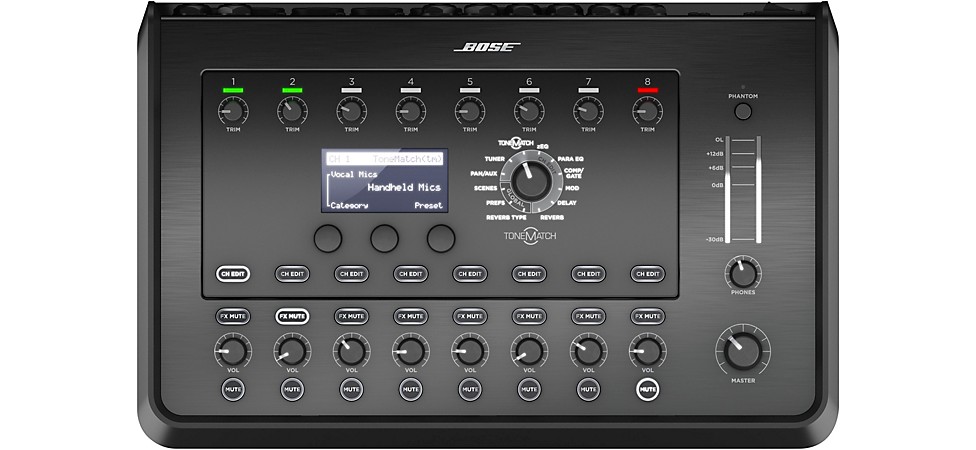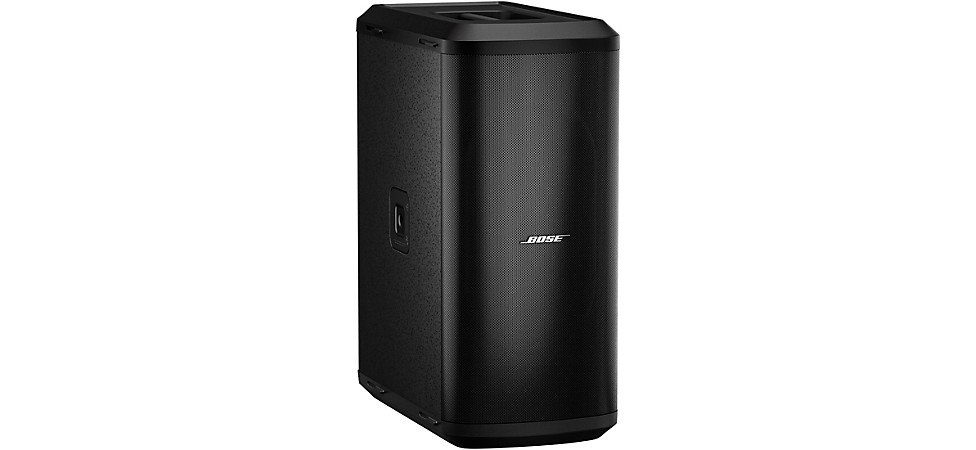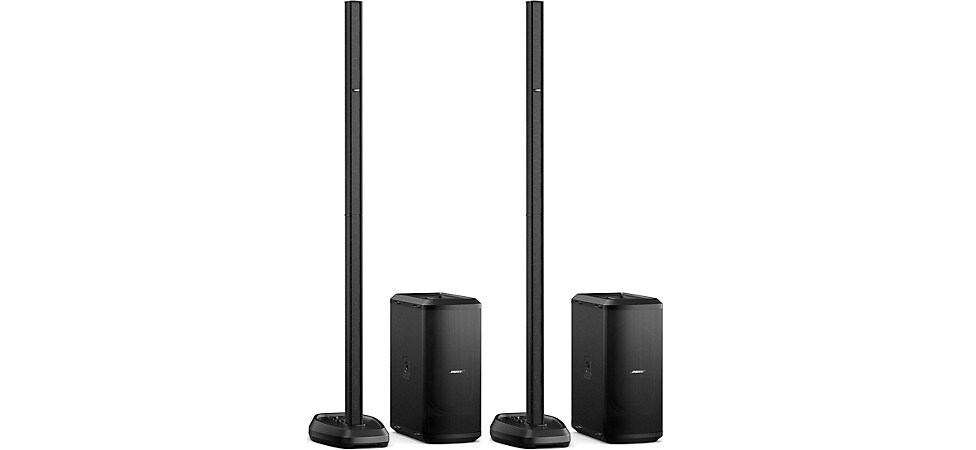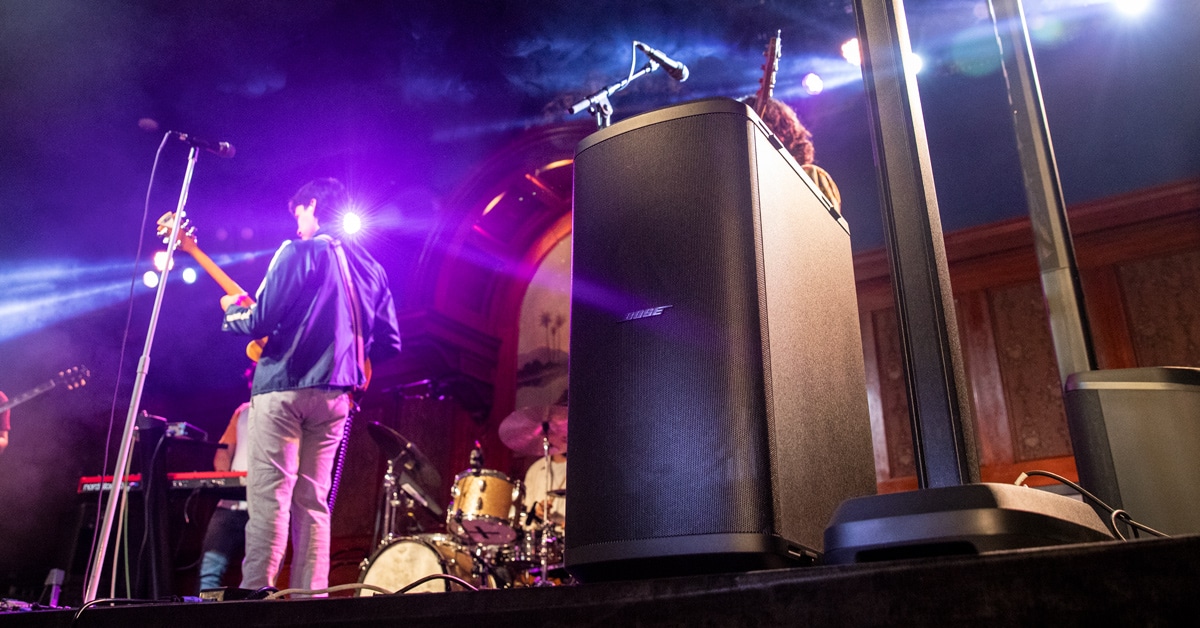The innovative, modular and blissfully portable Bose L1 Pro Line Array System is essential DIY gear for singer-songwriters, DJs and bands who must provide their own PA systems on the go. These systems can make sure your sound is covered wherever you perform, from small or large indoor venues to “pop up” gigs in the great outdoors.
A long-time vet of the L1 project since the L1 Model II debuted in 2007, Bose portable systems lead Craig Jackson gives us the inside story on the evolution of the L1 Pro.
What makes a line array design, such as the L1 Pro, preferable to other portable PA system designs?
Craig Jackson: One of the big benefits of line arrays is the way they control the propagation of sound. They generally give you a very wide horizontal pattern with tight vertical control, which results in less reflection within the space. Imagine a wedge of sound that goes out at 180 degrees. You're providing audience members with almost the same sound quality, whether they are in front of you, or off to the extreme left and right sides.
When you designed the L1 Pro, were you envisioning specific customers?
Jackson: Absolutely. One that first comes to mind is a solo singer-songwriter that performs in many different kinds of venues. The other extreme might be a mobile DJ who is doing weddings and other events. They’re typically bringing out a stereo system, whereas a solo singer-songwriter will use a singular system.
Now, what is important to each of them? A DJ may care more about bass extension than a singer-songwriter, but they still care about portability. In addition, they’re likely going to interface to the system with a DJ mixer up front, and that has to be accounted for.
We try to think through all of the different customer types. For example, what would a local bar band that has to bring their own PA to venues need? Maybe they have a couple of these systems positioned behind them as a PA—and maybe for some monitoring—with a mixer up front. Perhaps it’s a hybrid system where they are only putting vocals and maybe some acoustic instruments through them, and the rest of the sound comes from their backline. We want to cover the range of all the different types of customers and artists who may use the product—anyone who would go into a Guitar Center and try it, quite frankly.
How do you design a system for a range of potential users with very different sonic needs?
Jackson: That's a good question. We have three main products within the L1 Pro family. The L1 Pro8 is the most portable, so if you're a singer-songwriter playing in small venues, that's a good go-to product if you don’t need a lot of low end. Then, we have a bridge product called the Pro16 that can be used if you're a singer-songwriter, but it also works for a band that wants to put instruments through the PA that need some low-frequency extension. It's still portable, and it works great for those musicians who play in bands, but also do solo gigs, or even DJs, who really love the system. The Pro32 is the best performing system for a singer-songwriter, DJ or band. To cover that need, we developed two different bass boxes. The Sub2 is a large bass box that gives you similar performance to a 15" speaker. The Sub1 is a portable, powered bass box that performs much like a 12" speaker—similar to what the Pro8 gives you in bass extension. The customer can make the choice of what experience they want to have: a Pro32 with a Sub1 or a Pro32 with a Sub2.
We also have a technology called ToneMatch that lets users fine-tune the system. For example, a singer-songwriter can say, “I’m using an acoustic guitar,” or “I'm using a specific model of microphone.” We provide them with a ToneMatch EQ that optimizes that microphone or that instrument for that specific L1 system, whether it's the Pro32, Pro16 or Pro8.

Pictured: Bose L1 Pro8
Can a user tweak or refine the ToneMatch settings?
Jackson: Yes. Think of ToneMatch as an EQ which represents what a sound engineer would do to source for a live performance. Whether it's a singer-songwriter trying to get a basic guitar-vocal setup, or a band attempting to dial in the right kick-drum setting, or a DJ seeking the best loudness curve, ToneMatch is designed to get you 95 percent there. Then, everything else is a little bit of your icing on the cake. You can dial in your signature sound from there.
How does the onboard ToneMatch tech in the L1 Pro differ from what you get in the outboard ToneMatch T4S and T8S compact mixers?
Jackson: The ToneMatch presets in the onboard L1 Pro systems and the compact T4S and T8S mixers are almost 100 percent the same. There are a couple of presets that didn’t make it into the L1 Pro, but all of the mainstream presets for Taylor guitars, Audix mics and things like that, are all in there. Where we've seen our customers leverage and embrace the T4S and T8S mixers is when they want to extend their input-channel count to have more sources. The mixers also provide independent effects and dynamics processing for each channel, as well as a master reverb you can share across the mixer’s master bus. So, while the ToneMatch settings are much the same as those on the L1 Pro, the T4S and T8S offer more channels, more processing and more flexibility.

Pictured: Bose T8S Tonematch 8-channel Mixer
What does the L1 Mix app for iOS and Android offer?
Jackson: In 2022, the performance tools people use are different than the last time we introduced an L1, so we wanted to provide control of the system on mobile devices. At its simplest level, the L1 Mix app offers wireless control of all of the features within your L1 Pro. The workflow is the same, so the app is super intuitive and super easy to use.
In fact, you can place your mobile device on a mic stand and make tweaks to the L1 system without having to turn your back to the audience. You can just tap your mobile device, make a little tweak and not have to get out of the moment. You can stay present and dial in a bit more reverb or adjust EQ on the fly. The app also allows you to get to some of the product’s sub-features just as easily.
It’s worth mentioning that we built in some haptic feedback, so when you turn the app’s virtual knob, you actually feel the knob turning. Sometimes, you want that analog-style feedback when you’re touching a virtual control—especially if you’re looking at the audience while you’re making a change.
How have you evolved and refined the system in other ways from prior L1 generations?
Jackson: With the L1, it's hard because you have a product that is very well regarded. It’s like, “How do we advance this and not mess up the things everybody loves?” So, we knew there were things we wanted to keep the same, but we also wanted to push the envelope in other areas.
Happily, one of the cool things at Bose is that most of the people on the team have some kind of connection to music or are performers themselves. We also get feedback from customers all the time, and we ask ourselves, “What are our customers saying, and what could we do better?” Across the board, there were two common themes.
First, we needed to get higher performance from an SPL and bass extension standpoint. The DJ community and bands gave us that feedback. If a band had a super-loud drummer, the legacy systems had a little bit of a challenge keeping up with that. We knew that was something we wanted to make better in this new family.
The other primary focus was making the system even more portable. We asked ourselves, “How can we make it more powerful and give it more bass, but also make it more portable than ever before?” That's a really hard thing to do, but that was the challenge we put to the design team.
To make the array smaller, we knew there were driver technologies we could look at, so we went down that road. And some of the things you’ll notice if you own a Model II and look at something like a Pro32, is that the array is smaller, lighter and way more powerful. That got carried across the family from the Pro8 to the Pro16 and so on.
Then, we had to figure out the bass thing. We didn’t want to have these big, heavy squares, like conventional bass boxes, because they're not easy for one person to carry. You have to extend your arm way out, and it's just not a good experience.
We played with a lot of different bass designs, and some were an improvement in portability, but not necessarily an upgrade from an audio standpoint. At that point, one of the engineers said, “Hey, what about looking at a racetrack [rectangular] driver? They're used in other industries, but have not been used in consumer pro-audio products.”
So, we did a bunch of listening, and a bunch of experimentation, and we felt like we got such a good result that we were kind of all in on it—even knowing there was a risk that the market might not react favorably to something that was unconventional. But the racetrack drivers really paid off, because if you look at something like a Pro8 or a Sub2, they're these very slender bass boxes that are very powerful yet portable. We’ve all been in these situations where a load-in is the worst, or the gear won’t fit into your car, so ease of transport was a super-high focus for us. Several of the worst injuries I’ve had in my own life occurred while trying to carry too much gear into a venue really quickly because I was double parked. We’ll all lived it, and all you want to do is make it better—especially if you’re still doing it.
What were the key challenges of using a racetrack driver versus a more standard speaker design?
Jackson: As we went through the development and were scaling the design to be bigger, we found that making them more reliable and robust was hard to do. But that’s where having these amazing engineers that we work with at Bose is so wonderful. It was not as easy as picking an oval racetrack driver off the shelf, throwing it in there, and building a cabinet around it. There was a lot of refinement of the driver to get it to do what we needed it to do.
In addition, it's tricky in our industry to do things that are a little left of center. We focus on that only if it delivers a benefit to the customer. If we find something that can really and truly offer a better experience—such as the racetrack drivers—we're willing to take a chance. Even so, we were a little surprised at how much people immediately got it. I expected the industry might go, “That's a little weird. I need to check it out or hear it or whatever.” But the racetrack-driver concept was embraced right away—which shows yet again the importance of portability.

Pictured: Bose Sub2 Powered Bass Module
When you stack multiple Sub1 or Sub2 speakers for increased bass, you can set them to Cardioid Mode for more directional low-end performance. What does that mean for the musician and the audience?
Jackson: As a feature, Cardioid Mode is probably more important to the DJ community than a singer-songwriter. Bass generally propagates omnidirectionally—an even 360 degrees in all directions. That might be good in some situations, but a DJ probably doesn’t want blowback of bass coming back onto the stage, getting into their microphone or simply being too loud right where they’re standing.
Unlike an omnidirectional situation, Cardioid Mode cancels out the low-end energy that's coming backwards, while letting the energy going forward continue moving forward. Basically, it’s taking stuff out that you don’t want coming back to you. We’ve heard horror stories from DJs about doing outside events and getting yelled at because bass is going back behind them to houses, buildings, or other nearby properties. Having Cardioid Mode as a way to control bass and focus it where the music is supposed to be is really important to them. But even with bands, you don’t want stuff bleeding back into the microphones and making the stage sound harder to mix. That's a real problem, and this technology is used for pro tours to keep the stage sound a lot cleaner.
How can someone find the best L1 Pro system for their needs?
Jackson: The simplest way to look at it is, based on what you’re doing, how loud do you need to be, and how much bass do you need? Also, a DJ is usually going to require a stereo system, whereas a solo singer-songwriter may only need a single system.

Pictured: Bose L1 Pro32 Portable PA Pair With Dual Sub1 Powered Bass Modules
Although you and your team design the L1 systems for more-or-less specific uses, have you ever seen them used in ways you didn’t expect?
Jackson: Across the whole family, the thing I see people do that we hadn't expected is using a system at home for things like karaoke or movie night.
How would you sum up the L1 Pro family?
Jackson: Tone, coverage and portability. No matter which system you have, we want to give you the best tonal balance and coverage pattern throughout the room you’re performing in. We want your audience—wherever they are in the venue—to hear your performance clearly. Finally we wrap all of that up into a highly portable package that makes it easy to quickly setup, breakdown and load in and out of the venue.










